Farming in Miniature -
Further Discoveries
Johillco (see Volume 2 page 440)
Page numbers refer to Farming in Miniature Volume 2; bold numbers in brackets refer to photos in the Johillco chapter.
Click on a thumbnail to enlarge.
|
Tootsietoy Copies
In
the Johillco chapter we explained how John Hill & Co. started
producing copies of American Tootsietoys in 1932, at the instigation of
the wholesaler Bedington, Liddiatt & Co.Ltd. At first the
toys were sold in boxed sets which copied Tootsietoy's packaging almost
exactly, but with MADE IN ENGLAND
included on the box lid. A fascinating recent discovery is a
Johillco tractor with the name TOOTSIE
TOY cast on it (described below), showing just how blatant was
the abuse of the Tootsietoy trade mark by the British plagiarists.  From September 1932, Bedington Liddiatt stopped using the Tootsietoy name, no doubt at the insistence of Tootsietoy's lawyers, and the boxed sets had new packaging marked MINIATURE TRANSPORT TOYS. We can now illustrate the Field Battery Set mentioned on page 441, which included two examples of the Johillco tractor in khaki as a gun tractor, and contrast it with an original Tootsietoy set no.5071. The Tootsietoy army tractors had U.S.A. W-1881 cast on the sides of the ammunition box behind the driver, whereas there was no lettering on the sides of the British tractors. On the British set, note B.L.& Co.Ltd. printed on the box lid (for Bedington, Liddiatt & Co.Ltd.) and also, on the box insert, the slip of paper reading MINIATURE TRANSPORT TOYS (BRITISH) glued over the name TOOTSIETOYS. The insert even had Tootsietoy's number 5071 printed on the fold-down edge! FIELD BATTERY was rubber-stamped on the side of the lid. We have also seen a later version of this set, in a box with JOHILLCO JOYTIME MINIATURE METAL TOYS MADE IN ENGLAND on the lid. This wording was surrounded by illustrations of Johillco vehicles, including in one corner the tractor and trailer, and in another corner the crawler tractor and road-mending machine. In the centre of the box insert was printed FRONT LINE ARTILLERY SET, but the contents were identical to the earlier version pictured here. Bedington Liddiatt went out of business in 1933, but it seems clear that Johillco continued to produce their own versions of the Tootsietoy-copy sets. 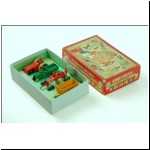 We have not yet found a British version of the Tootsietoy no.7003 Farm Tractor Set. It seems quite likely that such a set was produced, and the contents were pictured in (8). This photo shows a boxed version of the American set, with contents as (7) (some items in different colours). 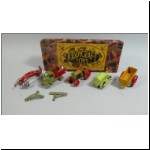 However there were very similar contents in this Kiddycraft Toys set, which contained the Johillco Farm Tractor, Farm Trailer, Crawler Tractor, Road-Mending Machine (with scraper and rake pieces) and Mack Coal Lorry. The box was a larger version of the box in (9). The tractor was painted khaki, showing that that colour was not restricted to military sets. The figure lying in the back of the coal lorry is a non-original extra! No.617 Tractor (page 441)  On this example of the Johillco tractor, the interference fit of the body and chassis castings at the front of the model has worn loose, allowing the body to hinge upwards from the chassis, although they are still connected by the back axle. This is fortuitous, allowing us to take a good photo of the TOOTSIE TOY lettering cast underneath the bonnet. This must be a very early version of the tractor, produced before the change of name to 'Miniature Transport Toys' in September 1932. In other respects, the model is as (3), including MADE IN ENGLAND cast under the chassis. All other examples of the tractor that we have examined have a plain panel under the bonnet, after the lettering had been removed from the die. The Johillco Mack truck has also been found with TOOTSIE TOY underneath (in that case the lettering had been partly machined off the casting). It is quite possible that other Johillco vehicles exist in this form, and we would be very interested to hear of any examples (please e-mail Robert Newson). Cattle and Horse Floats Four-wheeled Cattle
Float (page 442)
 Float as (19) but with medium grey interior, in an original red paper-covered unlabelled lift-off lid box. Two-wheeled Horse or Cattle Float (page 442) We do wonder about
the authenticity of the HEREFORD
BULL CART box shown in (17).
The use of the name JOHN HILL &
COMPANY (rather than Johillco) and the rubber-stamped catalogue
number are unique to this box, and no other examples of the box have
come to light. Our doubts were fuelled by the sale at auction of
Johillco and other models in 2011 in boxes with fake labels (referred
to on page
441). However, we can say for certain that the horse or cattle
floats are usually found in an unlabelled box covered in shiny red
paper, as shown above.
Tinplate, Wood and Wire Models  As (29) with large wheels, but wheels painted yellow. Horse and Roller (wide) with seat (page 443)  As (33) with higher level seat, seat and roller painted black. Horse & Hay Rake with seat (page 443)  As (39) with large wheels, but wheels painted yellow. Horse & Reaper (page 443) 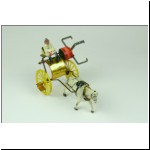 As (44) but red and gold reaper.  Similar to (46) but with the main red and green colours reversed.  As (48) but with red wheels. Horse & Water Cart (page 443) 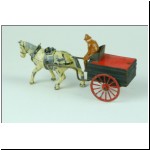 As (50) but unpainted seat. Horse & Water Cart (larger-scale) 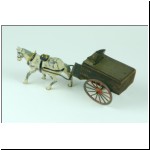  This larger-scale Water Cart (not seen before) has a footboard for the driver. The second photo shows the relative size of the new discovery, with (50) behind. Black tank, with red wheels. The seat and the tinplate top were gold, although most of the gold has worn off (160 mm). Horse & Timber Wagon (page 443)   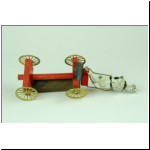 This wagon differed from (51) in several respects - notably the front axle was attached direct to the front bolster, so the wagon could not be steered. Also there were no wires to hold the log (which instead was glued in place) and there was no provision for a tandem horse. The bolsters were made of plywood and the chassis was a wooden dowel, all painted red. A tinplate footplate, painted a matching red on one side, attached the wire shafts to the wagon and was fixed to the front bolster with a single nail. The lead wheels were painted yellow (200 mm). Horse & Rotary Plough (page 443)  As (54) but with gold tinplate seat and plough shares. 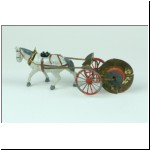 As (54) but with gold tinplate seat and plough shares on a red wooden drum. The other sides of the plough shares were bare metal. |
© Robert Newson, Peter Wade-Martins & Adrian Little